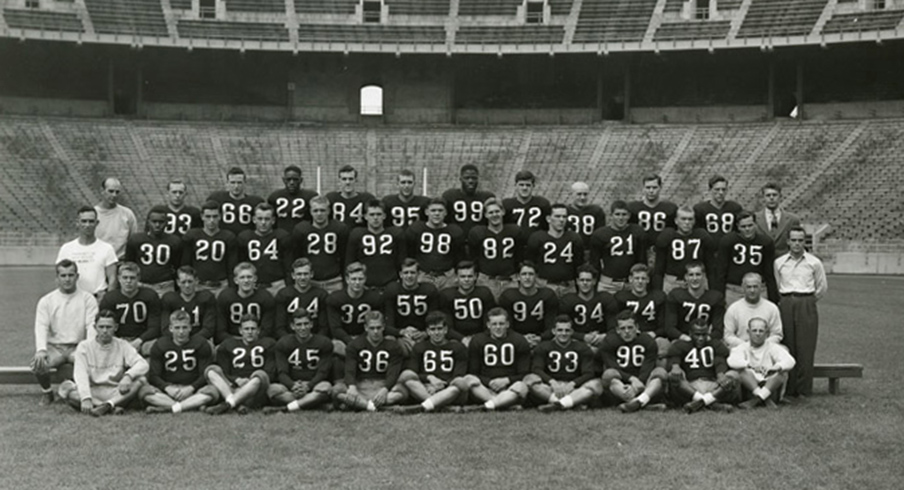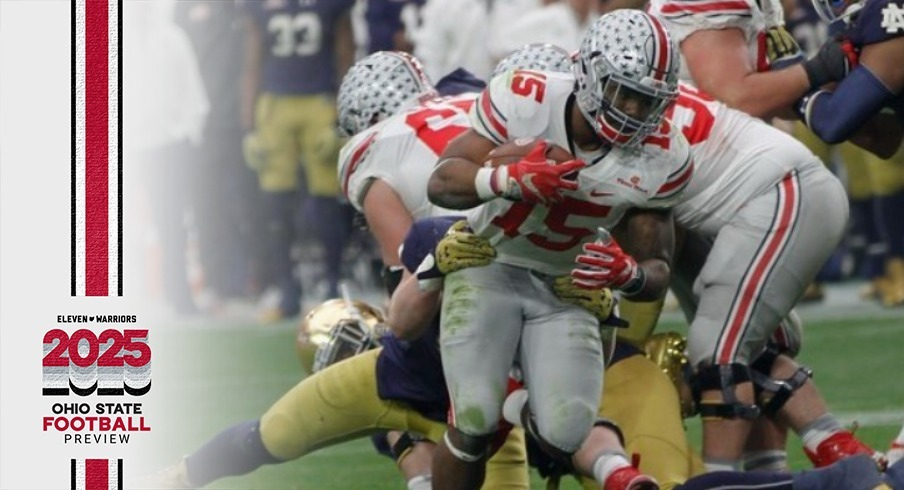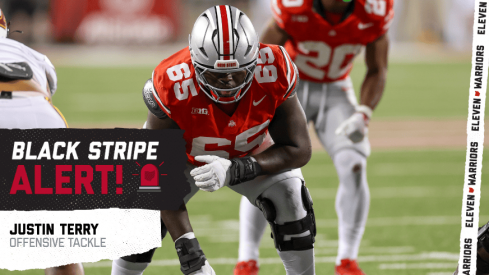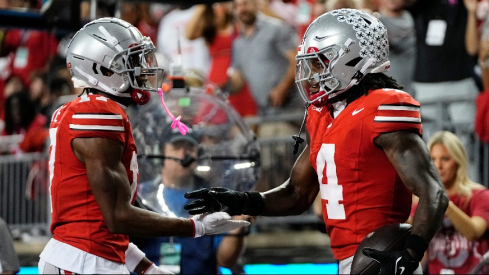Ohio State now claims nine national championships, seven of which are undisputed.
Some came within a few years of each other, but none ever happened back-to-back. For the first time since 2015, the Buckeyes get a chance to repeat and make school history in 2025. Their previous bids have been a mixed bag.
Years like 1969 and 2015 saw infamously close scrapes with another title run, but there have been forgettable campaigns to follow a college football crown in the illustrious history of Ohio State, too.
Where did those previous repeat bids fall apart? Are there any lessons to learn for this year’s team? We’re taking a stroll back through the history books to see.
1943 (3-6)
Ohio State’s first attempt at a repeat title collapsed the furthest of any from college football’s mountaintop, but there’s good reason for it.
The Buckeyes returned just five players from their 1942 championship squad under the guidance of legendary coach Paul Brown. Why? World War II was in full swing, and many of Ohio State’s potential players were in the ROTC program. Per wartime rules, ROTC members were prohibited from playing varsity sports.

Ohio State limped to a 3-6 record, though four of the losses came to ranked teams, including No. 4 Michigan, which finished as Big Ten co-champion. Star Les Horvath returned to the roster in 1944 and won the Heisman Trophy while leading the Buckeyes to a perfect 9-0 record, though Army would be crowned national champions.
1955 (7-2)
When Les Horvath returned to Ohio State in 1944 after a one-year hiatus in 1943, he won the Heisman Trophy. Howard “Hopalong” Cassady didn’t take a hiatus after earning first-team All-American recognition for the Buckeyes during their 1954 championship run, but he too won the Heisman his next year playing.
Cassady picked up 958 yards at a gaudy clip of six yards per carry with 14 rushing touchdowns in 1955. Unfortunately, one team managed to slow him down, Stanford, which held him to 11 carries for 37 yards. Ohio State lost 6-0 to the then-Indians, now Cardinal on the road, effectively killing its repeat ambitions in Week 2.
But especially in 1955, a national championship was far from everything for a team. And even as the Buckeyes fell once more to No. 11 Duke in Week 4, they rallied around Cassady and future Pro Football Hall of Famer Jim Parker.
Ohio State defeated two ranked teams in No. 15 Wisconsin and No. 20 Iowa then took the bus to Ann Arbor, Michigan as the No. 9 team in the land to face the No. 6 Wolverines as underdogs. A then-record crowd of 97,369 fans turned up at the Big House, only to watch Michigan snap the ball in Ohio State territory just one time.
The Buckeyes dominated the Wolverines 17-0 and claimed their second consecutive Big Ten championship. It was their first win in Michigan Stadium since 1937.
1958 (6-1-2)
Ohio State entered 1958 as the national favorite to repeat despite losing All-American guard Aurealius Thomas and team MVP Bill Jobko. The Buckeyes returned a stocked backfield featuring returning second-team All-American Don Clark, future Pro Football Hall of Famer Dick LeBeau and soon-to-be All-American Bob White. But warning signs emerged early of the team’s flaws.
Clark posted 98 rushing yards but No. 1 Ohio State struggled at home to beat No. 20 SMU, winning just 23-20, then scraped by with one-score victories against a pair of unranked opponents in Washington and Illinois.
A 49-8 drubbing of Indiana inspired hope that the team had found its footing, but the next three weeks decimated both the Big Ten and national championship hopes of the Buckeyes. A rain-soaked day against No. 13 Wisconsin in Week 5 produced a 12-12 tie in a slog to snap Ohio State’s 13-game winning streak.
No. 11 Northwestern capitalized on the last momentum and shut out the Scarlet and Gray 21-0 seven days later, then a second tie by a 14-14 scoreline against No. 8 Purdue eliminated them from conference championship contention. Which is a great shame, because the Buckeyes bested No. 2 Iowa, the future Big Ten champ that year, immediately following their three-game winless stretch.
A 20-14 triumph in The Game punctuated a happy end to an otherwise disappointing repeat attempt.
1962 (6-3)
For the second straight time after winning a national championship, the Buckeyes failed to win so much as a Big Ten title the following year. Then again, the 1961 crown is one of the two iffy titles claimed by Ohio State, with the FWAA handing it to 8-0-1 OSU while the AP, Coaches and NFF all recognized 11-0 Alabama as their respective national champions.
Perhaps fittingly, this is the second of three three-loss seasons that followed a claimed championship for Ohio State. The Buckeyes were out of the national picture by Week 4, when they were handed their second loss of the young season by No. 8 Northwestern in the Shoe.
A 28-14 pecking-apart by the Hawkeyes took Ohio State out of the Big Ten race two weeks later, leaving the squad a pedestrian 3-3. Three straight victories rounded out the season, at least, including a cathartic 28-0 Michigan demolition.
1969 (8-1)
Remember that pleasant memory against the Wolverines, part of a nine-year stretch with seven Ohio State triumphs in The Game. Now it’s time to talk about arguably the most painful Michigan memory in Buckeye lore.
Ohio State rolled to a national championship in 1968, knocking off No. 1 Purdue in a 13-0 shutout victory before disarming the No. 1 USC Trojans and Heisman Trophy-winning running back O.J. Simpson in the Rose Bowl 27-16 to cap a perfect 10-0 season. Simpson’s Heisman was later revoked. (Norm Macdonald, may he rest in peace, can explain why.)
Freshmen were ineligible in those days. Ohio State won that year’s title with a unit loaded with sophomores, famously dubbed the “Super Sophs” for that reason. An all-time great quarterback in Rex Kern. One of the best defensive linemen in team history, Jim Stillwagon. Single-season and career interceptions school record holder Mike Sensibaugh. One of the most feared hitters in college football history, Jack Tatum, who joined Sensibaugh in the secondary. Jim Otis, one of the defining fullbacks of the Woody Hayes era and a consensus All-American.
All of that talent returned from Ohio State’s 1968 squad. The Buckeyes debuted at No. 1 in the polls and stayed that way as they flattened the first eight opponents on their nine-game schedule by 27 points or more. They arrived to Ann Arbor against No. 12 Michigan – led by first-year head coach Bo Schembechler, formerly Hayes’ top assistant – off a 42-14 victory over No. 10 Purdue.
Much like freshman ineligibility, two more features of this bygone college football era were the lack of both a national championship game and the Big Ten’s no-repeat rule for the Rose Bowl. Ohio State didn’t have bids lined up with any other bowls. The Buckeyes weren’t going to play a postseason game in 1969, regardless of the outcome of The Game.
Beat Michigan, repeat as national champions. The formula was that simple for Ohio State on Nov. 22, 1969. But as many reading this already know, the Buckeyes fell 24-12 that fateful day in one of the biggest upsets in college football history.
If there were a College Football Playoff in 1969, Ohio State could have rallied around its veterans and gone on a run as it did after its latest loss to Michigan 55 years later. The Buckeyes were undoubtedly the most talented team in college football that season. Hayes later called it his best team. But the man Woody mentored weaponized his own system against him, and such a CFP world would be foreign to both resting football legends.
1971 (6-4)
When the Super Sophs turned seniors in 1970, they posted an undefeated 9-0 regular season that featured a vengeful 20-9 victory over No. 4 Michigan. Ohio State lost the Rose Bowl to No. 12 Stanford, but was still named co-national champion by the NFF alongside Texas during the regular season.
Of all the titles Ohio State claims, that is the only one in which it lost the last game of its season. It’s considered disputed for a reason, but goes down as the final national championship on Hayes’ record. His teams came up a game short of that crown each year from 1972 through 1975. But 1971 was a rebuilding year.
The Buckeyes lost to Colorado in Week 2, rattled off five wins, then closed the year on a three-game losing streak to Michigan State, Northwestern and No. 3 Michigan, finishing 6-4.
2003 (11-2)
Ohio State possessed a roster stocked full of talent following its 2002 national championship, but lost its most talented piece of all, rising sophomore running back Maurice Clarett, to a season-ending suspension. Clarett went down a tumultuous path before ultimately finding his way – something he touched on during his hour-long conversation with our 12th Warrior subscribers last week.
Lydell Ross didn’t pack the same punch as a feature back, averaging just 4.3 yards per carry, and the Buckeyes escaped with one-score wins against San Diego State, No. 24 North Carolina State and Bowling Green. The 2002 squad hardly looked like a world-beater against its own handful of unranked teams, but this time, the dam broke.
Ohio State went into Camp Randall Stadium and rushed for a meager 69 yards against No. 23 Wisconsin, who pulled ahead with a 79-yard touchdown with 5:20 to play, one of just 10 passes the Badgers threw. The magic of 2002 was gone.
The Buckeyes bounced back nicely with a five-game winning streak, at least, knocking off No. 9 Iowa, No, 14 Michigan State and No. 11 Purdue in the process. But Jim Tressel’s only loss to No. 5 Michigan in his 10 seasons as head coach left a sour taste.
At least Ohio State took out its emotions in a 35-28 Fiesta Bowl win over No. 8 Kansas State. But if the Buckeyes had Clarett – the Heisman Trophy frontrunner entering that offseason – who knows how this repeat bid might have gone differently.
2015 (12-1)
The hope in 2025 is that Ohio State's internal promotion of a new offensive coordinator goes better than it did a decade ago.
Like 1969, the Buckeyes’ 2014 national championship was propelled by a star-studded group of sophomores, including 1,800-yard rusher Ezekiel Elliott, Big Ten Defensive Player of the Year Joey Bosa, offensive line anchor Taylor Decker, star wide receiver Michael Thomas, dynamic linebacker Darron Lee and impeccable safety Vonn Bell.
Urban Meyer and his staff always thought 2015 was the year after signing such a ridiculous recruiting class in 2013. But the Buckeyes had one too few competent offensive coordinators and one too many starting quarterbacks.
Tom Herman’s departure to become head coach at Houston left Ed Warinner to call plays. Cardale Jones initially won a starting quarterback competition that lingered until the first game of the year, then the Buckeyes balked and swapped back to J.T. Barrett when the passing offense didn’t look how they wanted without their main passing mastermind in the building.
Elliott masked a lot of offensive deficiencies. He rescued Ohio State at Indiana in a 34-27 victory, rushing for 274 yards in just 23 carries with three touchdowns. But the Buckeyes ranked just 52nd nationally in passing yards per game (247.1).
Then Elliott was hospitalized with a staph infection during the week leading up to Ohio State’s home game against No. 9 Michigan State. It affected his condition as a downpour turned the contest into a slog.
Elliott received just 12 carries and only gained 33 yards. The Buckeyes were held to an abysmal 46 passing yards and 132 yards of total offense while Michigan State managed 294. A 41-yard Michael Geiger field goal as time expired secured the upset for the Spartans.
Ohio State recovered to trounce No. 12 Michigan 42-13 on the road in Jim Harbaugh’s first game as head coach, but Michigan State had already stolen the Buckeyes’ spot in the Big Ten Championship game and knocked them out of the four-team CFP conversation. Another team that would have benefited from a 12-team playoff, especially as they trounced No. 8 Notre Dame in the Fiesta Bowl 44-28.
The Buckeyes’ roster is overhauled in 2025 after their 2024 national championship, but Brian Hartline’s promotion to offensive coordinator should, in theory, go better than Warinner’s after learning from Ryan Day for nearly a decade and Chip Kelly for a year. This campaign also features a quarterback battle, one that will hopefully play out better than Jones and Barrett’s.
Ohio State can afford a slip-up in the modern era, unlike in 2015 or 1969. But that will do nothing to hedge the excitement building for a season-opening showdown with No. 1 Texas.



